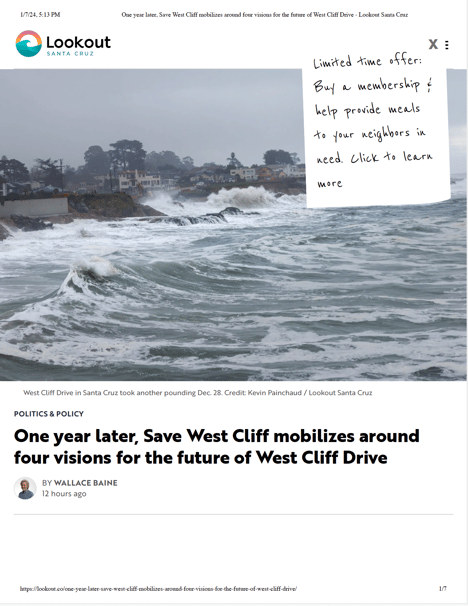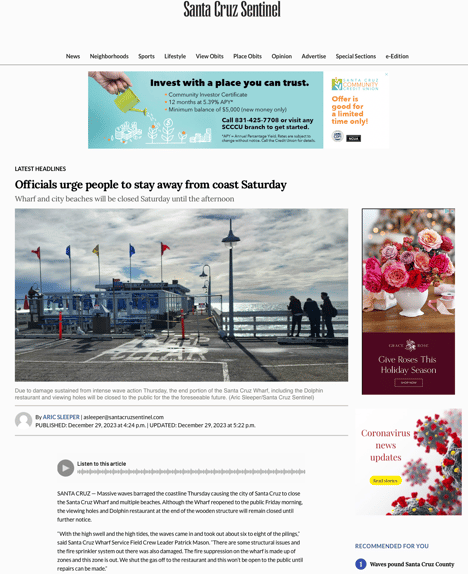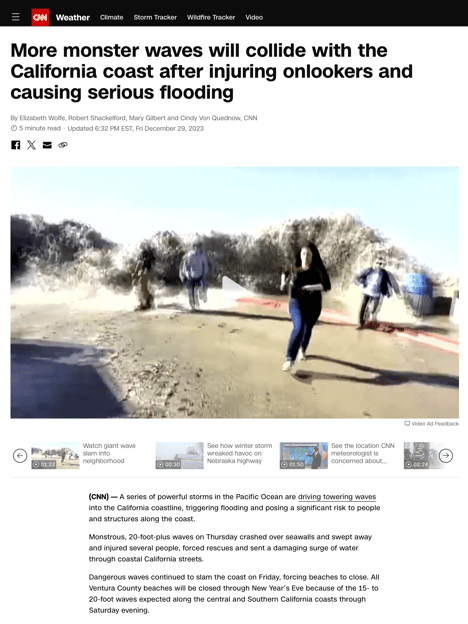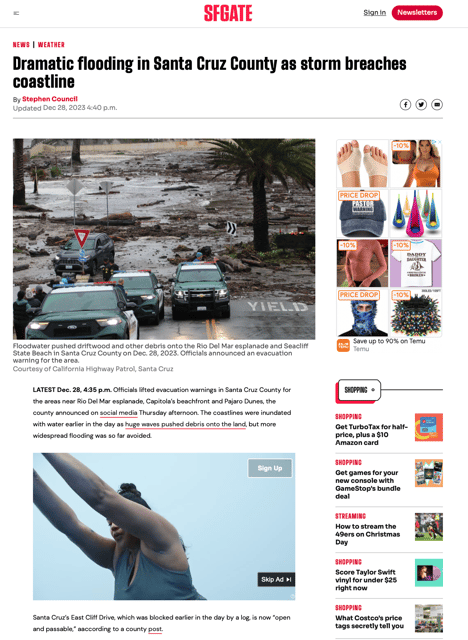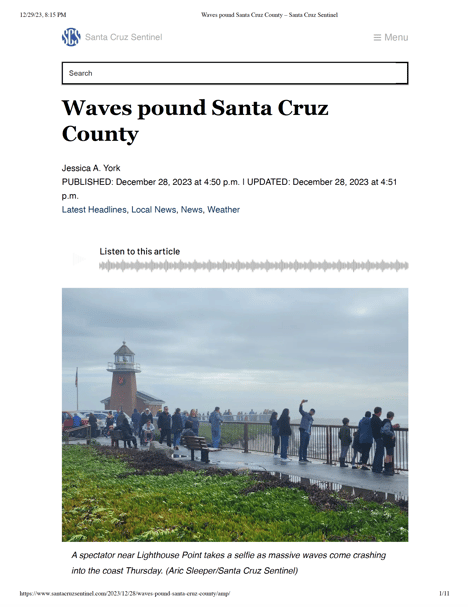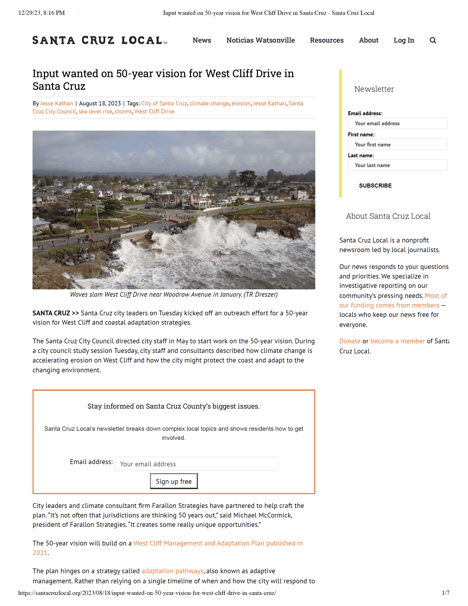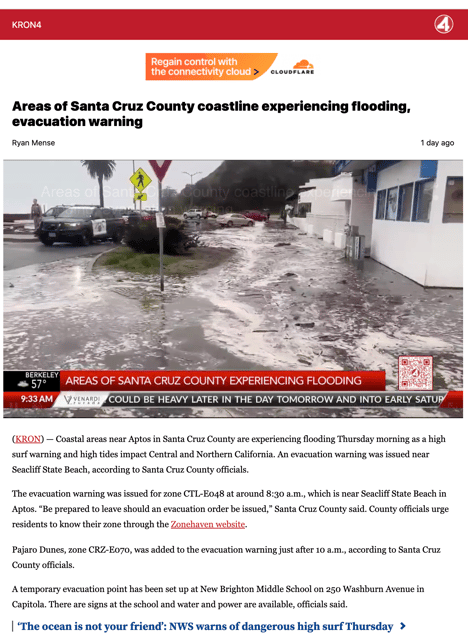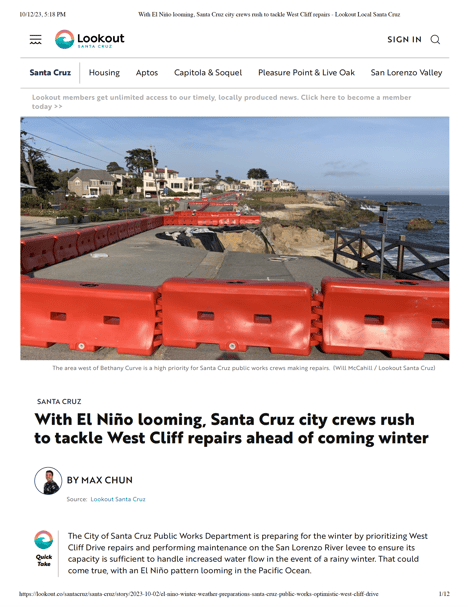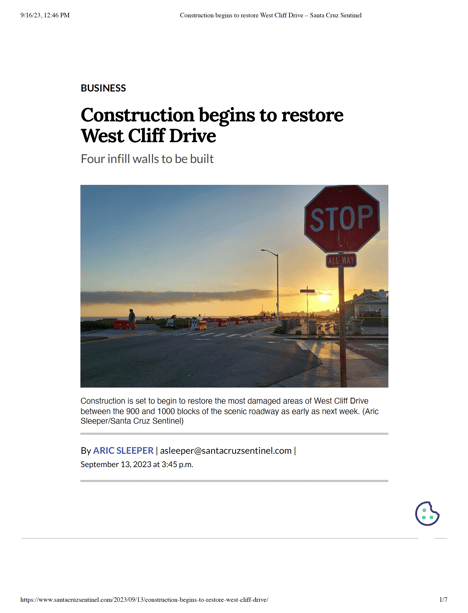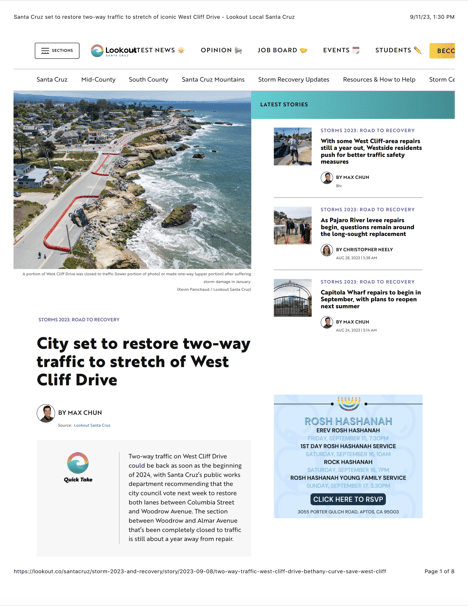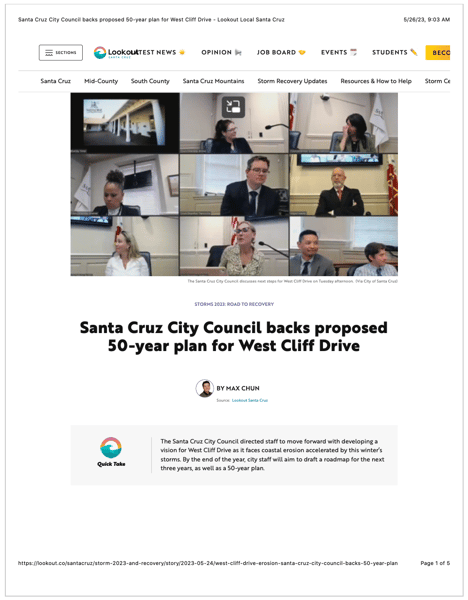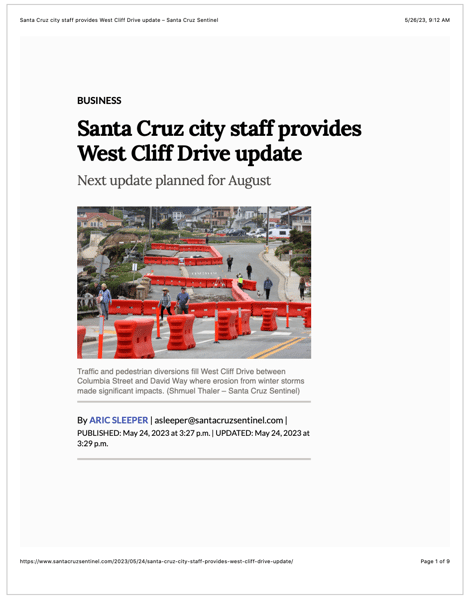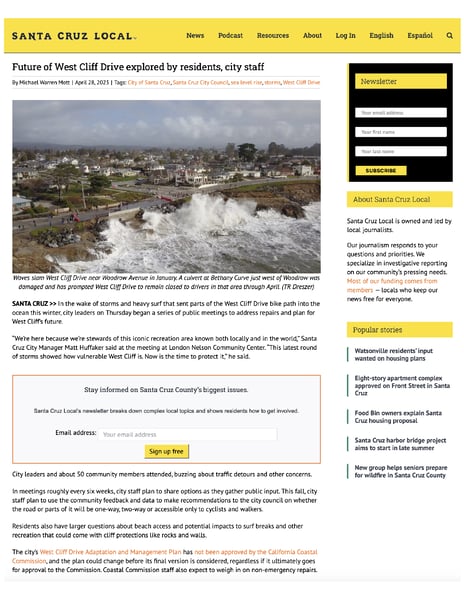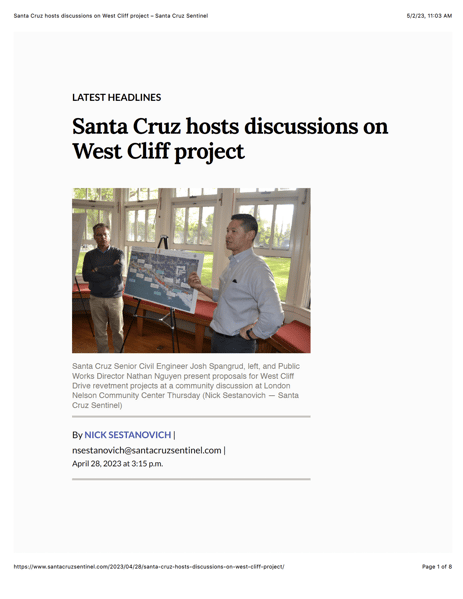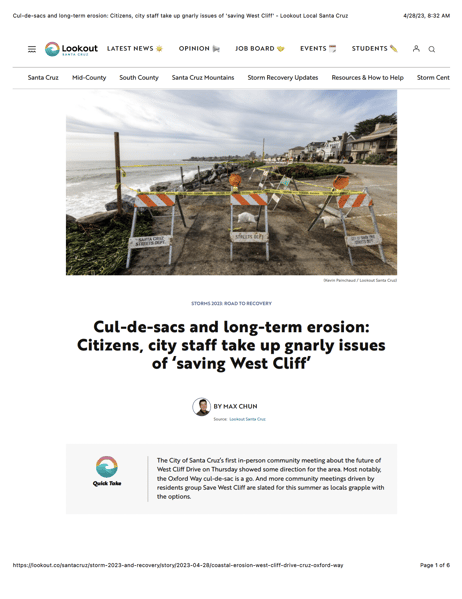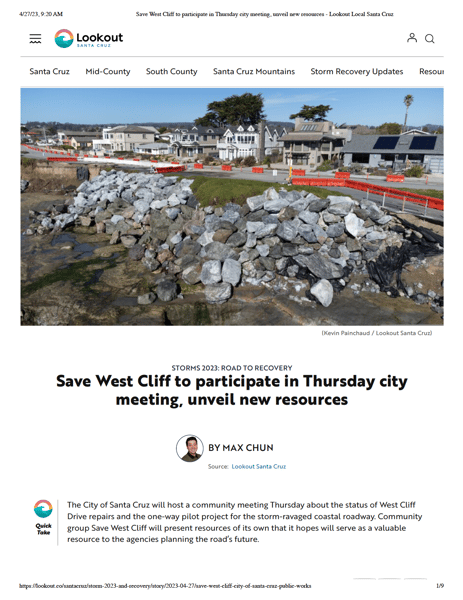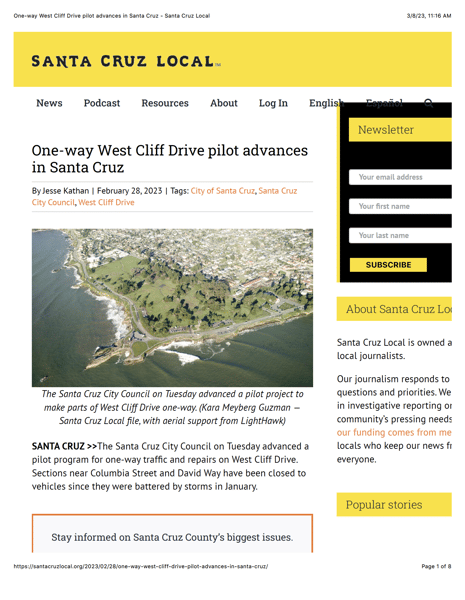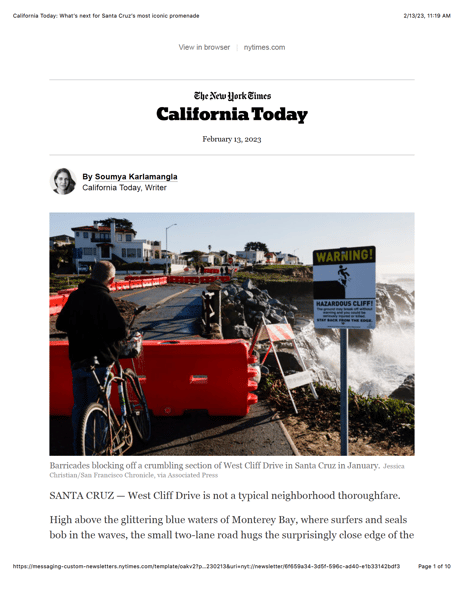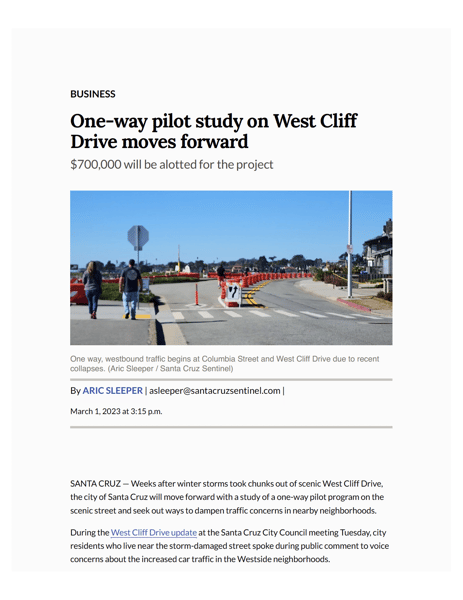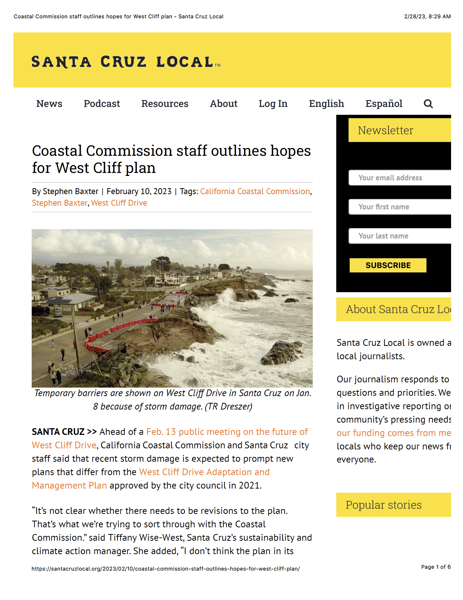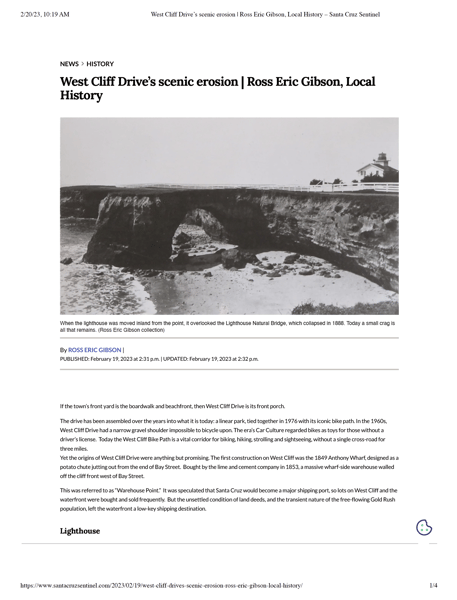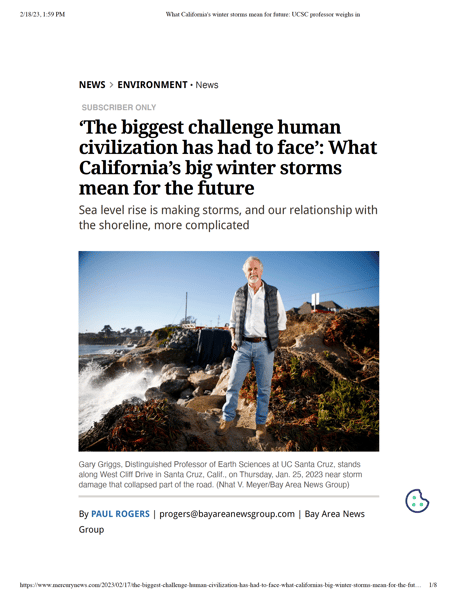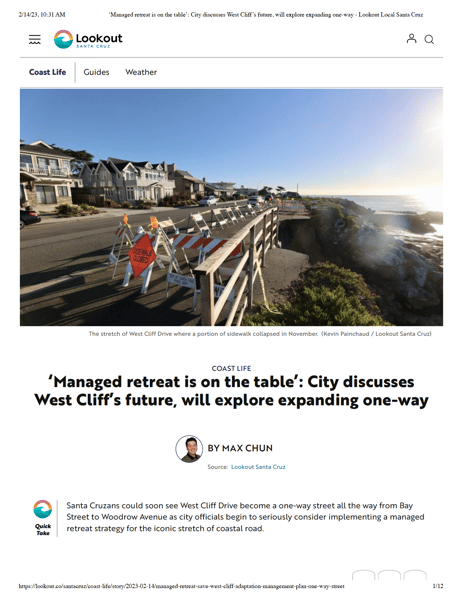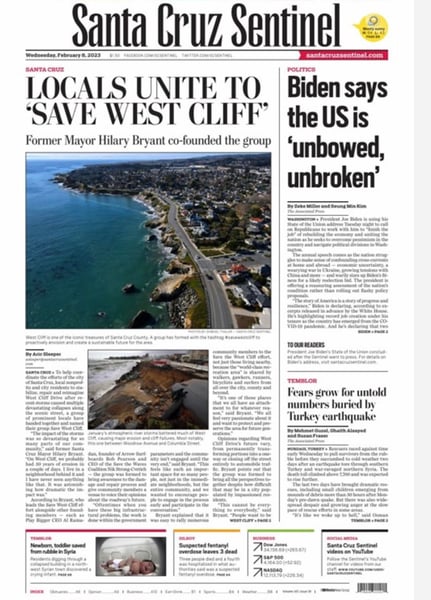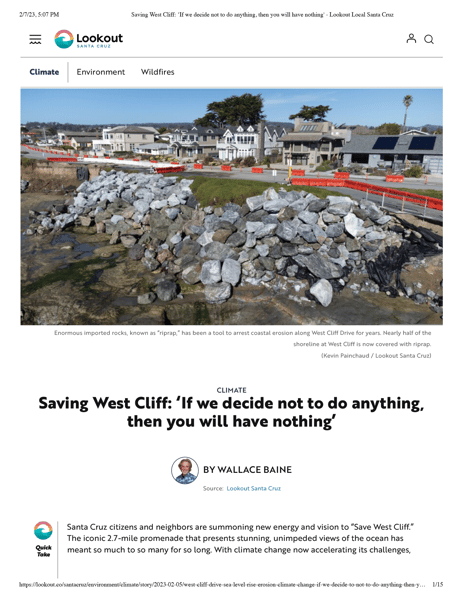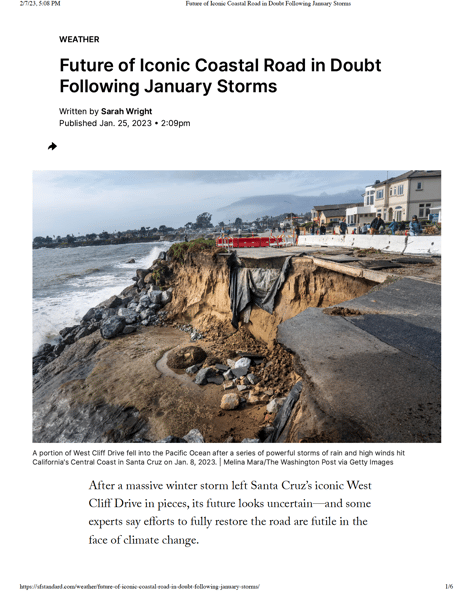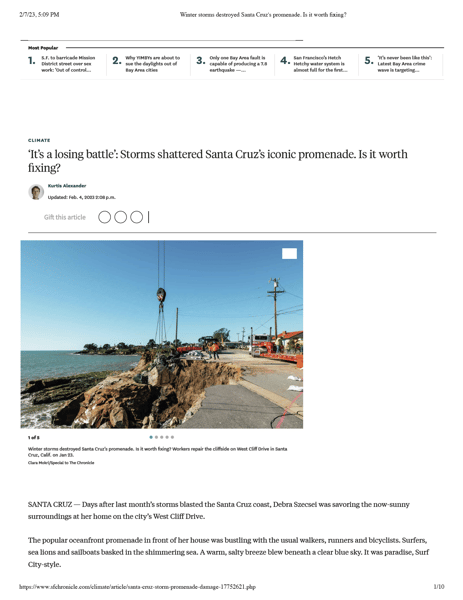LATEST PRESS
Lookout Santa Cruz
Surfers know the ocean’s tendencies and temperaments better than anyone and should be part of the city’s climate resilience planning process, argue Santa Cruz surfing legends Nat Young, Peter Mel and Anthony Ruffo, along with neighborhood organizer Deborah Maddock Elston. Instead, they are being left out – as are any mention of west swells and bomb cyclones. Here, they push to know why and say the city is not doing enough to plan for a climate-resilient future for West Cliff Drive, the Beach Flats and Santa Cruz surf culture.
Lookout Santa Cruz
Councilmembers voted unanimously against approving a plan to turn all of West Cliff Drive into a one-waystreet. Instead, they backed an alternate plan put forward by Shebreh Kalantari-Johnson that asked city staff toreturn to the council by the end of the year with answers to big community questions surroundingneighborhood impacts, traffic routing and how much clifftop space the community needs.
Santa Cruz Local
The process of carrying out the 50-year vision “is moving way too fast,” said Don Iglesias, a Pelton Avenue resident. “I feel blindsided that the staff is chasing grant funding for a one-way pilot before developing an implementation plan.”
Lookout Santa Cruz
““Unless we have a vision for what West Cliff should be in 2072 or 2073,” Al Ramadan said, “we’re wasting our time. It’s a futile exercise. It’s one where we get into this cycle of storms coming in, smashing the road, smashing the cliffs, smashing our recreation areas. We wait around for the feds to come in and supply money, and then we do emergency repairs. Rinse and repeat. That’s not a solution.”
Santa Cruz Sentinel
“Due to the high swell predicted for Saturday morning, the portion of West Cliff Drive from Columbia to David Way will be closed again to pedestrians Saturday, at least until the tide lowers in the afternoon. In addition to the closure of the wharf and city beaches such as Main Beach, Cowell Beach and Its Beach, among others.”
CNN
“In central California’s Santa Cruz, the sheriff’s office issued an evacuation warning for some areas on Thursday, which included areas of Rio Del Mar, where seawater filled beachside roadways and pushed against some homes, CNN affiliate KION reported. The warnings were lifted later in the day.”
SFGATE
“Multiple rounds of rainfall, powerful winds and the full moon’s gravitational pull are contributing to the surges of seawater, SFGATE reported Tuesday. The National Weather Service’s Bay Area office warned of deadly conditions, and wrote in a high surf warningfor Thursday, “Never turn your back to the ocean!” Further up the coast from Santa Cruz, evacuations were in effect around Stinson Beach. The high surf warning will remain in effect until 3 a.m. Friday.”
Santa Cruz Sentinel
“Due to the structural damage and we can’t pump any sewage out, we shut down the entire wharf,” Thomas said, shortly after 10 a.m. “Right now we just made the call to get PG&E out here to isolate the gas because the waves are coming up and hitting the gas main and we don’t want that to start free-flowing.”
Santa Cruz Local
Sand is “a lost resource,” for protecting the coast, said Al Ramadan, a member of Save West Cliff. The community group is dedicated to preserving West Cliff Drive and the surrounding coastline.
Ramadan points to the Santa Cruz Small Craft Harbor, built in the early 1960s, which broadened Seabright State Beach. He envisions similar widenings for beaches like Its Beach or Pyramid Beach. “One of the thoughts is, if that works for Seabright, could that work for West Cliff?” he asked.
KRON 4
“Please avoid the area and do not attempt to drive across flooded areas,”
Santa Cruz Sentinel
The National Oceanic and Atmospheric Administration’s latest prediction puts at 70% the chances that this year might evolve into a “strong” El Niño.
Santa Cruz Sentinel
Construction is set to begin to restore the most damaged areas of West Cliff Drive between the 900 and 1000 blocks of the scenic roadway as early as next week.
Lookout Santa Cruz
City set to restore two-way traffic to stretch of West Cliff Drive
Lookout Santa Cruz
“We are less concerned about the one-way, two-way debate than we are about the ‘no way’ situation,” he said. “No access is a disaster. If you think traffic in the neighborhood is bad now, wait until there’s no access.”
Santa Cruz Sentinel
“We’re under a tight timeline,” said Nguyen. “If we can essentially get all of these repairs done by the middle of October there is a potential that we can get 100% reimbursement, but we are still waiting for (the Federal Highway Administration) to respond to our damage assessment forms. Again, we’ve had initial contact, we’ve submitted those forms, and now we are waiting for that process to continue to play out.”
Santa Cruz Local
“We can’t continue to stay in the planning phase,” Bryant said. “There has to be some decisions made and they’re going to have to come sooner than later.”
Santa Cruz Sentinel
“We’re welcoming everyone in to tour around the different sessions and chat with our presenters and learn more about what’s going on,” said city Communications Manager Erika Smart.
Lookout Santa Cruz
“We’ve struck a chord, people love this place and don’t want to see it fall into the ocean.”- Al Ramadan
Lookout Santa Cruz
“It’s a way to take the land, sea and infrastructure and look at them holistically,” Hilary Bryant said. “That way we’re able to move forward with whatever the community decides should be done with correct historical context, structure and backbone.”
Santa Cruz Local
Al Ramadan, a founder of the community group Save West Cliff, said he hopes the long-term plan “moves us from a short-term focus of protecting the road to a longer term view of protecting the recreation area as a whole.”“West Cliff is more than a road with pipes under it,” he said. “It is a living ecosystem with a very rich history.”
New York Times
“This was sort of a wake-up call,” said Gary Griggs, a professor of earth sciences who has taught at the University of California, Santa Cruz, since the 1960s. “I’ve never seen this much damage this quickly in my 55 years here. So it’s time to step back and say, ‘This is what’s coming.’”
Santa Cruz Sentinel
“One of the things that we’re doing as an internal, city-wide team is approaching West Cliff holistically as one of our great city treasures,” said Schmidt. “It’s not a public works issue. It’s not a climate issue. It’s not a recreation issue. It is an asset and something that we want to make resilient and accessible to all.”
Santa Cruz Local
“The city and us have been in dialogue about how best to govern West Cliff for some time, including how the (West Cliff Drive Adaptation and Management) Plan fits in,” Kahn wrote. “With the recent storms and damage, it’s even more clear to us that the plan needs that longer-term visioning before anything is submitted to us for action.”
Santa Cruz Sentinel
"Meanwhile, the cliff path was eventually enlarged into “Cliff Drive” by 1889, then as the name “East Cliff Drive” came more into use, “West Cliff Drive” was coined to differentiate.”
Mercury News
"At this point, we have to start thinking longer term. We have to start agreeing on some things. Sea level is rising. We can measure it. We know it’s accelerating. So when do we decide we’ve got to do something? Gary Griggs”
Lookout Santa Cruz
Hilary Bryant, former Santa Cruz mayor and a Save West Cliff leader, said that as devastating as the storms were, they’ve provided the city with a timely opportunity to prepare the entire road for the future.
“It’s not just happening at one section — it’s all the way around, and we rarely have this kind of federal funding opportunity,” she said. “So as awful as it is, let’s be really thoughtful and strategic about how we look at this. I think it’d be a disservice to just look at the most damaged sections.”
Santa Cruz Sentinel
“It’s one of those places that we all have an attachment to for whatever reason,” said Bryant. “We all feel very passionate about it and want to protect and preserve the area for future generations.”
Lookout Santa Cruz
“This is an inflection point,” said Hilary Bryant, one of those former mayors and a primary advocate for “Save West Cliff. “This is a moment when we really have to make some significant decisions. I don’t believe we can continue to just patch up these spots that are falling in. There needs to be a more strategic, overarching look at the entire West Cliff environment and we need to think about how we want to protect that important piece of coastline for future generations — or not. That’s the other thing. If we decide to not do anything, then we will have nothing.”
The San Francisco Standard
“Griggs and Revell, along with a community group called Save West Cliff, say it may be time for a reality check.”
The San Francisco Chronicle
“We are Surf City, and it’s a place where people can access nature,” said Justin Cummings, a Santa Cruz County supervisor and former city mayor who joined the Save West Cliff group. “I’m just really hoping we can figure out a way to maintain that access.... But trying to stop the ocean from doing its thing is not going to work.”
SWC ©2025
Designed by The Drew Creative



